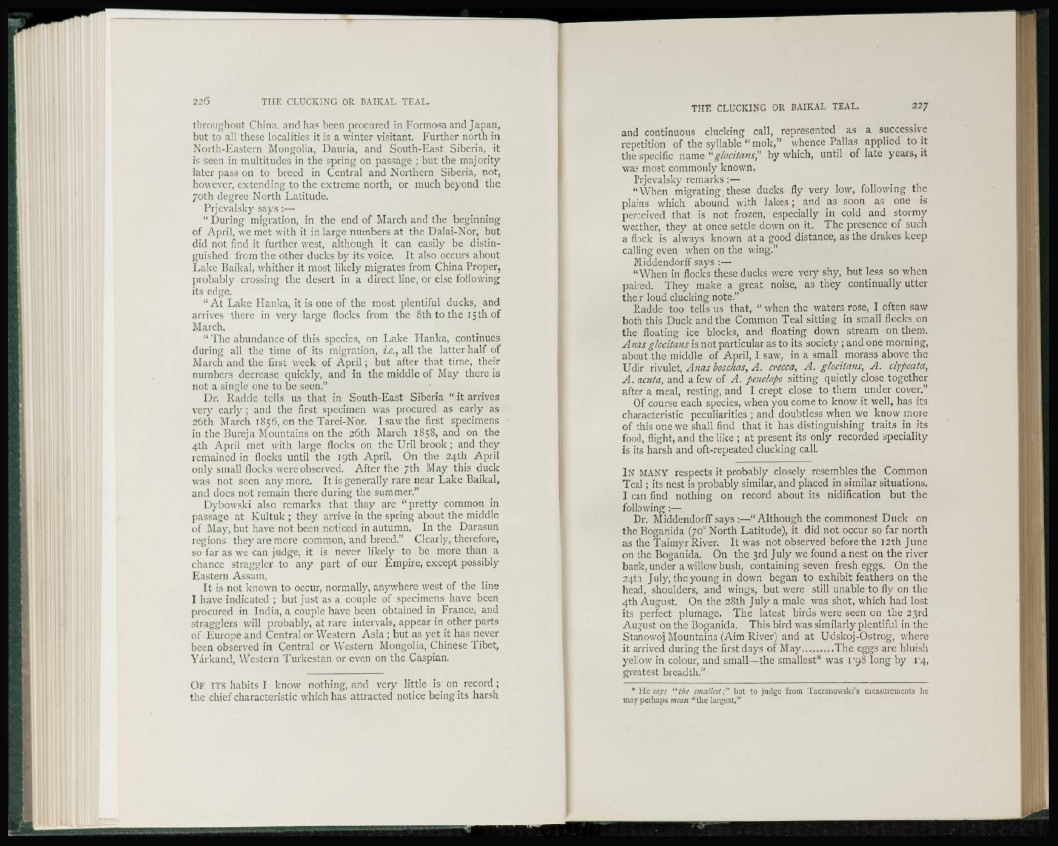
226 TIIF. CLUCKING OR BAIKAL TEAL.
throughout China, and lias been procured in Formosa and Japan,
but to all these localities it is a winter visitant. Further north in
North-Eastern Mongolia, Dauria, and South-Fast Siberia, it
is seen in multitudes in the spring on passage ; but the majority
later pass on to breed in Central and Northern Siberia, not,
however, extending to the extreme north, or much beyond the
70th degree North Latitude.
Prjevalsky says :—
" During migration, in the end of March and the beginning
of April, we met with it in large numbers at the Dalai-Nor, but
did not find it further west, although it can easily be distinguished
from the other ducks by its voice. It also occurs about
Lake Baikal, whither it most likely migrates from China Proper,
probably crossing the desert in a direct line, or else following
its edge.
" At Lake Hanka, it is one of the most plentiful ducks, and
arrives there in very large flocks from the 8th to the 15 th of
March.
" The abundance of this species, on Lake Hanka, continues
during all the lime of its migration, i.c, all the latter half of
March and the fust week of April ; but after that time, their
numbers decrease quickly, and in the middle of May there is
not a single one to be seen."
Dr. Raddc tells us that in South-East Siberia "it arrives
very early ; and the first specimen was procured as early as
26th March 1856, on the Tarei-Nor. I saw the first specimens
in the Bureja Mountains on the 26th March 1858, and on the
4th April met with large flocks on the Uril brook ; and they
remained in (locks until the 19th April. On the 24th April
only small flocks were observed. After the 7th May this duck
was not seen an)- more. It is generally rare near Lake Baikal,
and does not remain there during the summer."
Dybowski also remarks that thay are " pretty common in
passage at Kultuk ; they arrive in the spring about the middle
of May, but have not been noticed in autumn. In the Darasun
regions they are more common, and breed." Clearl)', therefore,
so far as we can judge, it is never likely to be more than a
chance straggler to any part of our Empire, except possibly
Eastern Assam,
It is not known to occur, normally, anywhere west of the line
I have indicated ; but just as a couple of specimens have been
procured in India, a couple have been obtained in France, and
stragglers will probably, at rare intervals, appear in other parts
of Europe and Central or Western Asia ; but as yet it has never
been observed in Central or Western Mongolia, Chinese Tibet,
Yarkand, Western Turkestan or even on the Caspian.
O F ITS habits I know nothing, and very little is on record ;
the chief characteristic which has attracted notice being its harsh
THE CLUCKING OR BAIKAL TEAL. 227
and continuous clucking call, represented as a successive
repetition of the syllable " mok," whence Pallas applied to it
the specific name" glocitans" by which, until of late years, it
was most commonly known.
Prjevalsky remarks :—
"When migrating these ducks fly very low, following the
plains which abound with lakes; and as soon as one is
perceived that is not frozen, especially in cold and stormy
weather, they at once settle down on it. The presence of such
a flock is always known at a good distance, as the drakes keep
calling even when on the wing."
Middendorff says :—
" When in flocks these ducks were very shy, but less so when
paired. They make a great noise, as they continually utter
their loud clucking note."
Radde too tells us that, " when the waters rose, I often saw
both this Duck and the Common Teal sitting in small flocks on
the floating ice blocks, and floating down stream on them.
Atias glecitans is not particular as to its society ; and one morning,
about the middle of April, I saw, in a small morass above the
Udlr rivulet, Anas boscluts, A. crecca, A. glocitans, A. clfpeata,
A. acuta, and a few of A. penelope sitting quietly close together
after a meal, resting, and I crept close to them under cover."
Of course each species, when you come to know it well, has its
characteristic peculiarities ; and doubtless when we know more
of this one we shall find that it has distinguishing traits in its
food, flight, and the like ; at present its only recorded speciality
is its harsh and oft-repeated clucking call.
IN MANY respects it probably closely resembles the Common
Teal; its nest is probably similar, and placed in similar situations.
I can find nothing on record about its nidification but the
following:—
Dr. Middendorff says :—" Although the commonest Duck on
the Boganida (70° North Latitude), it did not occur so far north
as the Taimyr River. It was not observed before the 12th June
on the Boganida. On the 3rd July we found a nest on the river
bank, under a willow bush, containing seven fresh eggs. On the
24th July, the young in down began to exhibit feathers on the
head, shoulders, and wings, but were still unable to fly on the
4th August. On the 28th July a male was shot, which had lost
its perfect plumage. The latest birds were seen on the 23rd
August on the Boganida. This bird was similarly plentiful in the
Stanowoj Mountains (Aim River) and at Udskoj-Ostrog, where
it arrived during the first days of May The eggs are bluish
yellow in colour, and small—the smallest* was lyS long by 1-4,
greatest breadth."
* He says "the smallest;" but to judge from Taczanowski's measurements he
may perhaps mean "the largest."